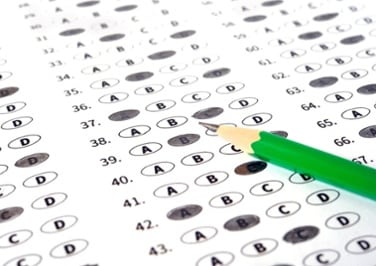This point in the school year can be one of the most stressful times for teachers and students alike: state’s standardized testing is underway. As the standardized testing monster storms throughout computer screens and bubble sheets in America, panic transcends. While the purpose of state testing is to evaluate student’s learning based on a set of given standards, it’s still a pressure cooker for teachers. This pressure, placed upon teachers, which can subconsciously burden students, calls for a much needed set of stress balls to ease tension!
As my students opened up the test and began the first question segment, I was always left thinking: Did I do enough? If only I had a few more weeks… If you’re an educator having similar thoughts about your own instruction please do the following: Stop. Breathe. Reflect. From my own experience, I can tell you that when I was in this position I did the opposite.
I paced around the room proctoring the test, simultaneously hoping osmosis would transmit to the minds of my students as they answered multiple choice questions. In reality I should have thought back to what I had done the entire school year: the formative assessments, the interventions, the student review lunches, or the times when we broke into a dance party for a much needed break. Yes, that’s it, I should have thought about all the hard work my students put forth, the insurmountable academic growth, and how I believed in them. Despite persecuting myself during that test time, I always found fun ways to relieve stress for the remainder of the day.
Tips for after the test

While sticking to the same schedule is ideal, testing windows often present a hiccup for the day-to-day teaching routine, especially since students have been sitting in silence for a few hours. During testing week, I preferred to provide a variety of kinesthetic, cooperative activities which engaged students while targeting multiple standards. Specifically, I found combining literacy activities with outdoors a hit.
There are multiple ways to weave nature and literacy together:
- Free writing
Simply use this as an opportunity to have students pick an area to sit in close proximity such as under a tree, a swing, or anywhere else nearby that allows for feasible writing spot, and have students free write.
CCSS.ELA-Literacy.W.4.10
Write routinely over extended time frames (time for research, reflection, and revision) and shorter time frames (a single sitting or a day or two) for a range of discipline-specific tasks, purposes, and audiences.
- Character and setting
Have students write a scene with a main character from their current literature novel. Students can place the main character in the present outdoor surroundings. Using what students know about the character based on thoughts and actions from the text, students can create a dialogue based on the outdoor school setting.
CCSS.ELA-Literacy.RL.4.3
Describe in depth a character, setting, or event in a story or drama, drawing on specific details in the text (e.g., a character’s thoughts, words, or actions).
CCSS.ELA-Literacy.W.4.3.b
Use dialogue and description to develop experiences and events or show the responses of characters to situations.
- Figurative language
Use the outdoor surroundings as inspiration for figurative language.
Example: (metaphor) The willow’s leaves are the garden’s umbrella.
CCSS.ELA-Literacy.L.4.5
Demonstrate understanding of figurative language, word relationships, and nuances in word meaning.
What outdoor literacy activities are you eager to try out?




